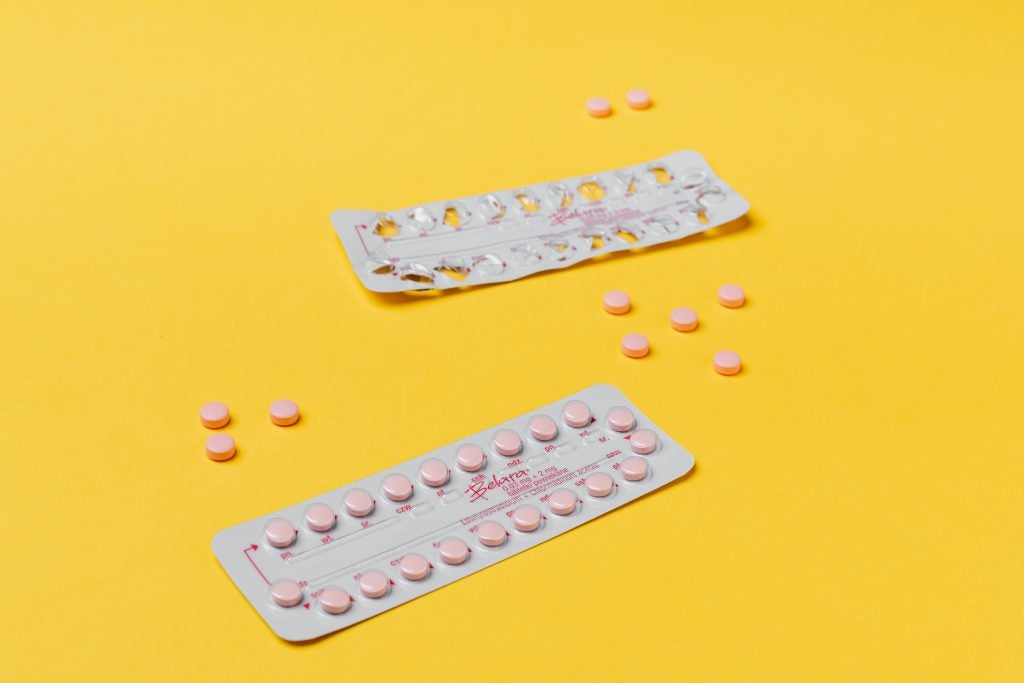Endometriosis is a painful female reproductive condition associated with chronic menstrual pain and infertility. Endometriosis occurs when endometrial tissue begins to grow outside of the uterus.1 This tissue is similar to the lining of the uterus.1 Although there is currently no cure for endometriosis, there are different types of treatment available that can help manage the symptoms.2 These treatment options may also help increase an individual’s chances of getting pregnant.1 Roughly 3% to 10% of females who are of reproductive age are affected by endometriosis.3
Table of Contents
What is Endometriosis?

Endometriosis occurs when the endometrium—tissue that typically lines the walls of the uterus—grows elsewhere in the body. The endometrial tissue may spread to the ovaries, fallopian tubes, pelvic tissue, and outer surface of the uterus.1 Endometrial growth can also occur in the vagina, cervix, vulva, bowel, bladder, or rectum.1
In a normal menstrual cycle, a complex system of hormones causes the endometrium to thicken, break down, and exit the uterus in the form of menstrual blood. Endometrial tissue that is displaced due to endometriosis follows the same life cycle; however, with no way to leave the body, the trapped tissue coagulates. This can result in the formation of cysts called endometriomas, which may later cause the development of painful and sticky scar tissue. Often, the scar tissue adheres to itself, causing other pelvic tissues and organs to stick to each other and resulting in severe pain and cramping.4
Causes
While the exact cause of endometriosis is unknown, there are a number of possible causes:4
- Retrograde menstruation occurs when some of the endometrial discharge, released during a female’s menstrual period, does not follow the normal pathway out of the vagina; rather, it travels backward, up the oviducts. These pieces of endometrial tissue become stuck within the pelvic cavity and settle onto irregular places outside of the uterus.4 While researchers previously thought that this was the most probable cause for endometriosis, new data shows that while 90% of females experience retrograde menstruation, only 10% actually have endometriosis.5
- Genetics may play a role in endometriosis. Research shows that “females who have a close female relative with endometriosis are five to seven times more likely to have it themselves.” 5
- The induction theory proposes that certain hormones and immune factors may promote the transformation of cells that line the abdomen (peritoneal cells) into endometrial tissue cells.4
- A faulty immune response may also impede the ability of the body’s immune cells to target displaced endometrial tissue, thus resulting in tissue buildup outside of the uterus.4
- Surgery on the abdominal area can also cause endometrial tissue to be picked up and transferred to a different area by mistake. This could potentially occur in surgeries such as Cesarean sections (C-sections) or hysterectomies.1
The medical community is still unsure about what exactly causes endometriosis. 1 It is also worthwhile to note that endometriosis is not contagious. 5 Thus, it cannot be passed from person to person through contact. 5
Risk Factors
Research shows that there are a number of risk factors, many of which arise during puberty, that may increase an individual’s likelihood of developing endometriosis.
- Early menstruation can increase the risk of endometriosis.4 On average, females begin to menstruate around 12 years old. While most females will start their period within the range of 10-15 years old, having a menstrual cycle that begins much earlier than this can indicate abnormal reproductive function.
- Short menstrual cycles, specifically those that are shorter than 27 days, are often a strong risk factor.4
- Low BMI can affect the regularity and general function of the menstrual cycle, which often throws the body’s hormones out of balance.4
- Never giving birth is another potential risk factor for endometriosis.4 Females who give birth after the age of 30 can also be at an increased risk for the disease.6
- Lastly, genetic predisposition has a strong influence. Research shows a six-fold increased incidence in females with a first-degree relative who has endometriosis (such as a mother, aunt, or sister).4
Scientists cannot conclusively point to one single risk factor, but rather have found that combinations of these issues are typically responsible for the onset of endometriosis.
Symptoms
Symptoms of endometriosis include severe, long-term pelvic pain, abnormal vaginal bleeding, infertility, long menstrual periods, pain during or after sex, and digestive issues.4 Some females may have no symptoms at all.

- Pelvic pain, often called “killer cramps,” can be relentless, and typical over-the-counter pain relief medications can help manage the pain.5 Painful menstrual cramps are one of the most common symptoms and may get worse over time.1 Additionally, some people may also experience chronic (long-term) pain in the lower back.1
- Abnormal bleeding is another possible sign of endometriosis.4 Females may experience heavy periods or experience spotting in between periods. Some may bleed after sex or have blood in their stool. However, abnormal bleeding does not always mean a female has endometriosis. Bleeding patterns vary greatly between individuals and should be judged as irregular only compared to that individual’s baseline.
- Infertility, or the inability to get pregnant, can be a sign of endometriosis. Roughly one-third to one-half of females who have endometriosis experience difficulty with getting pregnant.4 Having endometriosis does not necessarily mean a female cannot have children, but it may be more difficult for them to conceive. The more severe the endometriosis, the more difficult it may be to become pregnant. Surgery may help women who are hoping to become pregnant. 3
- Long menstrual periods that last more than seven days, or any abnormality in the menstrual cycle, can be a symptom of endometriosis.5
- Individuals may also experience pain during or after sex.1 This could affect uterine nerves and ligaments, causing pain when the growths are agitated by the movements of sex. The pain can be described as a “deep” pain, which is different from the pain that may be experienced at the vaginal opening when penetration begins.1 This pain may subside immediately after sex, or in more severe cases, last for a few days after intercourse.5
- Digestive issues such as nausea, constipation, and gastritis often occur in very severe cases when the endometrial tissue invades the intestinal wall.5 Diarrhea, bloating, and fatigue may also occur specifically during menstrual periods.4
Endometriosis can have a wide range of symptoms. Some individuals experience debilitating, chronic pain, while others may go most of their life without knowing they have the condition. Some people may have severe pain with mild endometriosis and others may have little or no pain with advanced endometriosis.4 If any or all of these symptoms persist, it can be beneficial to see a doctor for a proper diagnosis because an early diagnosis can help the patient to better manage the symptoms of endometriosis.4
Diagnosis
On average, it takes ten years to diagnose endometriosis from the initial onset of symptoms.5 This is often due to the high rates of misdiagnosis, as well as a general lack of information about endometriosis in both the medical community and public.5
The only definite way to diagnose endometriosis is through a laparoscopy.2 A laparoscopy is a surgical procedure where a small viewing tube with a camera and light, known as a laparoscope, is inserted through an incision in the abdomen.2 This allows doctors to clearly see the inner organs, and based on the presence of endometrial tissue, make a diagnosis.5 Doctors may also take a tissue sample in order to perform a biopsy that can aid them in making a proper diagnosis.2 Endometriosis cannot be detected with a computed tomography (CT) scan, a magnetic resonance imaging (MRI), or even an ultrasound.5 There is also no lab test for endometriosis, so patients cannot confirm the condition via blood, urine, or saliva tests.5
Treatment

To help manage the pain for endometriosis, pain relievers can be taken.2 These include ibuprofen or other prescription medication specifically made for endometriosis.2 Opioids may sometimes be prescribed for severe pain.2
Another form of treatment is hormone therapy and this includes birth control pills, progestin therapy, and gonadotropin-releasing hormone (GnRH) agonists.2 GnRH can aid in controlling the growth of endometriosis, but it is also known to cause temporary menopause.2 Birth control or an IUD may be used as a form of treatment if an individual is not trying to get pregnant. GnRH agonists may be used if an individual is trying to get pregnant.
For severe pain, surgical treatments may be required. Laparoscopic excision surgery, where the surgeon removes lesions or cysts, can be used to treat endometriosis.6 This surgery removes endometrial tissue that is lodged on and in different areas of the pelvic organs. It is possible for pain to return a few years after the surgical procedure.2 Additionally, endometrial tissue can be addressed with ablation or cauterization; however, this method is only used for less severe cases as it is a short-term remedy.5
Although hysterectomies used to be standard medical procedure when treating endometriosis, recent information indicates that they are rarely the most effective treatment. Since most cysts and lesions grow on areas around the reproductive organs, removing the uterus will have little to no effect.5
Support for Individuals with Endometriosis
Endometriosis is a common and often very painful condition for females. A resource for those who are seeking support is the National Endometriosis Foundation of America and its website can be visited here. This website offers resources such as fact sheets about endometriosis, toolkits on pain management, support groups, and much more.
Another resource is Endometriosis.org, a website that offers recent evidence-based news and information regarding endometriosis. It also offers information on an individual’s first consultation, how to cope, national support groups, finding a specialist, tips before and after surgery, and self-help books.
Concluding Remarks

Endometriosis is a chronic condition that affects many females. The condition occurs when endometrial tissue begins to grow outside of the uterus, and it is often associated with menstrual pain, as well as infertility. There are a number of possible causes for endometriosis, but the exact cause is unknown. If symptoms of endometriosis persist, it can be beneficial to see a doctor to get a proper diagnosis and to manage pain in a timely manner. Although there is no cure for endometriosis, there are various types of treatment available. Support groups are also available and may provide comfort for those with endometriosis.
References
- “Endometriosis.” Edited by Esther Eisenberg and E. Britton Chahine, Office on Women’s Health, U.S. Department of Health & Human Services, 1 Apr. 2019.
- “Endometriosis.” MedlinePlus, U.S. National Library of Medicine, 30 Apr. 2020.
- “Endometriosis.” UCLA Health, UCLA Obstetrics and Gynecology.
- Mayo Clinic Staff. “Endometriosis.” Mayo Clinic, Mayo Foundation for Medical Education and Research, 16 Oct. 2019.
- “What Is Endometriosis? Causes, Symptoms and Treatments.” Edited by Tamer Seckin, Endometriosis Foundation of America, 20 Sept. 2019.
- “Endometriosis.” Johns Hopkins Medicine.
Last Updated: 10 May 2020.
